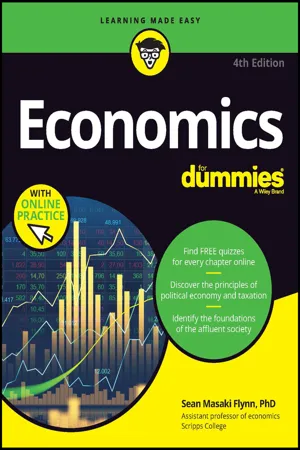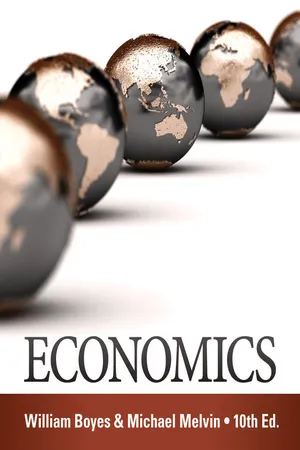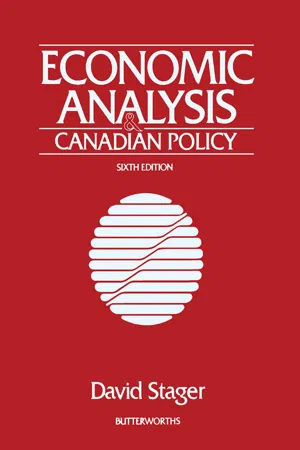Economics
How Markets Allocate Resources
"How Markets Allocate Resources" refers to the process by which goods and services are distributed in an economy. In a market economy, resources are allocated based on the interaction of supply and demand, with prices serving as signals for resource allocation. This system allows for efficient allocation of resources based on consumer preferences and producer incentives.
Written by Perlego with AI-assistance
Related key terms
1 of 5
6 Key excerpts on "How Markets Allocate Resources"
- eBook - ePub
Economics For Dummies
Book + Chapter Quizzes Online
- Sean Masaki Flynn(Author)
- 2023(Publication Date)
- For Dummies(Publisher)
market production to capture what happens when one individual offers to make or sell something to another individual at a price agreeable to both.In markets, the allocation of resources is facilitated by the fact that each resource has a price, and whoever is willing to pay the price gets the resource. In fact, market economies are often called price systems because prices serve as the signals that direct resources. Holding supply constant, products in high demand have high prices, and products in low demand have low prices. Because businesses like to make money, they follow the price signals and produce more of what has a high price and less of what has a low price. In this way, markets tend to take limited resources and use them to produce what people most want — or at least, what people are most willing to pay for.For instance, the guy who sells you a TV at a local retailer has no idea about the total demand for TVs in the world, how many tons of steel or plastic are needed to produce them, or how many other things weren’t produced because the steel and plastic needed to make the TVs were used for TVs rather than other things. All he knows is that you’re willing to pay him for a TV. And if he’s making a profit selling TVs, he orders more TVs from the factory. The factory, in turn, increases production, taking resources away from the production of other things.Markets have the benefit of figuring out, automatically, the things people want. To grasp why this is so amazing, consider that you live in a world of more than 8 billion people. It would be impossible for any single person to gather enough information to figure out what each of them most wants to buy. It would take several lifetimes to speak with each of them, even just to find out what they want for dinner, let alone all the other things they would most like to purchase on a typical day. But because production and distribution in modern economies aren’t centrally controlled (by a small number of government officials working together in a single place), nobody needs to know the big picture. - eBook - PDF
- Colin Harbury(Author)
- 2014(Publication Date)
- Pergamon(Publisher)
CHAPTER 2 Supply and Demand The work of this chapter is devoted to questions of resource allocation in the market for a single commodity. Resource allocation by the price mechanism is analysed with the use of the concepts of SUPPLY and DEMAND. In a market economy, resources are directed to the production of different goods by movements in their relative prices. If people want to purchase a good and price covers the cost of production, it is assumed that businesses will engage in its production in order to make a profit. If the price of a good is such that the amount which consumers wish to buy is not the same as the amount which suppliers are prepared to offer for sale, there will be some pressure on its price. If, on the other hand, price is such as to clear the market exactly with no disappointed consumers or producers, then the price and the market are said to be in EQUILIBRIUM. If price is above equilibrium there is excess supply of the good and producers will tend to compete with each other by lowering price. If the price is below equilibrium there is excess demand and some consumers will be prepared to pay more for the good, which will tend to push the price up. In such cases equilibrium is said to be stable, in that deviations from equilibrium set up economic forces which restore equilibrium. In some cases, e.g. when there are time lags between price and quantity changes, equilibrium may be unstable, when divergencies from equilibrium are not self-restoring. However, when a change occurs in the conditions of either supply or demand, such a reduction in costs or a shift in tastes, in so far as it exerts pressure on the price of a good, it will normally set up market forces leading towards a new equilibrium. The forces of supply and demand working through the price mechanism can be thought of as helping to solve the central economic problems of any society. Prices act, as it were, as signals which perform two functions. - eBook - PDF
Economics For Dummies
Book + Chapter Quizzes Online
- Sean Masaki Flynn(Author)
- 2023(Publication Date)
- For Dummies(Publisher)
Economists use the term market production to capture what happens when one individual offers to make or sell something to another individual at a price agreeable to both. CHAPTER 3 Producing Stuff to Maximize Happiness 49 In markets, the allocation of resources is facilitated by the fact that each resource has a price, and whoever is willing to pay the price gets the resource. In fact, mar- ket economies are often called price systems because prices serve as the signals that direct resources. Holding supply constant, products in high demand have high prices, and products in low demand have low prices. Because businesses like to make money, they follow the price signals and produce more of what has a high price and less of what has a low price. In this way, markets tend to take limited resources and use them to produce what people most want — or at least, what people are most willing to pay for. For instance, the guy who sells you a TV at a local retailer has no idea about the total demand for TVs in the world, how many tons of steel or plastic are needed to produce them, or how many other things weren’t produced because the steel and plastic needed to make the TVs were used for TVs rather than other things. All he knows is that you’re willing to pay him for a TV. And if he’s making a profit selling TVs, he orders more TVs from the factory. The factory, in turn, increases produc- tion, taking resources away from the production of other things. Markets have the benefit of figuring out, automatically, the things people want. To grasp why this is so amazing, consider that you live in a world of more than 8 billion people. It would be impossible for any single person to gather enough information to figure out what each of them most wants to buy. It would take sev- eral lifetimes to speak with each of them, even just to find out what they want for dinner, let alone all the other things they would most like to purchase on a typical day. - eBook - PDF
- William Boyes, Michael Melvin(Authors)
- 2015(Publication Date)
- Cengage Learning EMEA(Publisher)
top: ª Carsten Reisinger/Shutterstock CHAPTER 29 Resource Markets Preview Resource markets provide the ingredients for producing goods and services. They include the markets for labor, capital, and land in general terms, but more specifically they involve people and their jobs, physical and financial capital, and natural resources. In this chapter, we will look at how firms choose their resources and how firms draw on economic theory to help them decide which resources and how much of a given resource to use. In the chapters that follow, we will look at each market more closely, examining some of the societal questions and issues that arise in the process. FUNDAMENTAL QUESTIONS 1. Who are the buyers and sellers of resources? 2. How are resource prices determined? 3. How does a firm allocate its expenditures among the various resources? ª sarra22/Shutterstock.com 631 Copyright 2016 Cengage Learning. All Rights Reserved. May not be copied, scanned, or duplicated, in whole or in part. Due to electronic rights, some third party content may be suppressed from the eBook and/or eChapter(s). Editorial review has deemed that any suppressed content does not materially affect the overall learning experience. Cengage Learning reserves the right to remove additional content at any time if subsequent rights restrictions require it. 29-1 Buyers and Sellers of Resources There are three general types of resource markets: those for land, labor, and capital. The price and quantity of each resource are determined in its resource market . Rent and the quantity of land used are determined in the land market. The wage rate and the number of people employed are determined in the labor market. The cost of capital (the interest rate) and the quantity of capital used are determined in the capital market. Although each of these markets is somewhat unique, they are all markets, and thus they simply involve the demand for and supply of that particular resource. - eBook - PDF
Microeconomics, Macroeconomics and Economic Policy
Essays in Honour of Malcolm Sawyer
- P. Arestis(Author)
- 2011(Publication Date)
- Palgrave Macmillan(Publisher)
The firm is a substitute for the market, an alternative contracting mode or ‘governance structure’ (Williamson, 1985). It differs from the market not in terms of its function, but in the way it performs that resource allocation. Both the firm and market allocate resources among competing ends, and both are understood and evaluated in terms of the efficiency of their resource allocations. That allocative efficiency is essential; the scarcity of resources demands it. Since resources are limited, and there are not enough of them, we must make the most of the ones we have, allocating them to their most valuable uses. This resource allocation is the central problem – indeed, neoclassical economics recognises no other – so that the critical question about the firm is the nature of its resource allocation, and the firm and market distinguished by their allocation mechanisms. Whereas markets allocate resources ‘unconsciously’, without express intent, firms allocate them purposively, in accordance with a plan. Their operations are administered, and organised hierarchically, with resource allocations effected through ‘fiat’ or ‘command’ (Williamson, 1994). Employees of firms are directed by their management, rather than by the impersonal forces of the market. Their work is supervised rather than self-directed, dictated by the requirements of the firm, and serving its objectives, and that ‘supersession’ of market directives and incentives is the distinguishing mark of the firm (Coase, 1937). Firms are administrative units rather than units of production – ‘hierarchies’ rather than ‘production functions’ (Williamson, 1975). They centralise production, vertically integrating its operations, and develop not for technological reasons, but for governance ones (Williamson, 1985). It is not the indivisibilities or scale economies of production that explain the firm’s presence, but the opportunism and ‘bounded ration- ality’ of economic agents. - eBook - PDF
- David Stager(Author)
- 2013(Publication Date)
- Butterworth-Heinemann(Publisher)
They include questions about the rate of economic growth, the level of resources used in the economy, and how to provide flexibility in response to economic and other changes. The desired rate of economic growth is one aspect of the resource allocation decision. Economic growth can be illustrated, as in Figure 1.4, as an outward shift of the production-possibilities boundary. In Figure 1.1, combination C was unattainable because sufficient resources were not available to produce this combination of commodi-ties. However, if the economy decides to allocate more of its resources to producer goods to expand its productive capacity, the boundary may shift outward over time, as shown by the outer curve in Figure 1.4. Combination C becomes attainable, indicating that more of both public goods and private goods can be made available. The level of resources available to the economy has been taken as fixed at any given time. While this is so, the quantity of resources actually used, and particularly labour services, can be changed fairly quickly. This involves decisions about the quantity of labour service to goods, and labour of various skill levels. Technology—the knowledge of alternative processes, raw materials, and sources of raw materials for producing specific commodities—is generally available to any economy, although some effort may be required to adapt technology to the needs of a particular economy. Thus the major conditions influencing the choice of production methods are the amount of labour and capital available and the willingness to forgo current consumption in order to develop capital goods and to improve the skills of the labour force.
Index pages curate the most relevant extracts from our library of academic textbooks. They’ve been created using an in-house natural language model (NLM), each adding context and meaning to key research topics.





